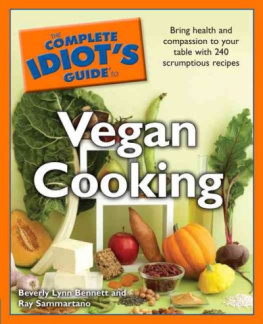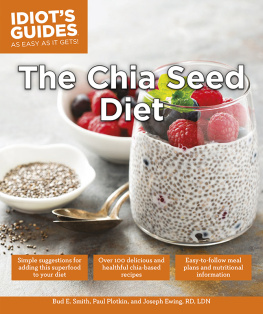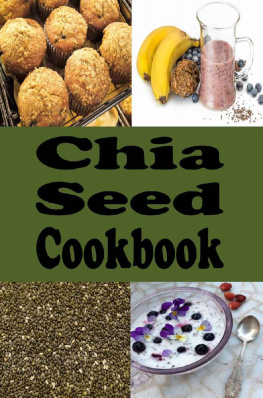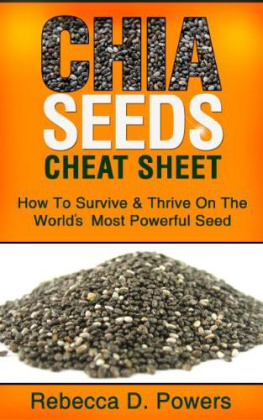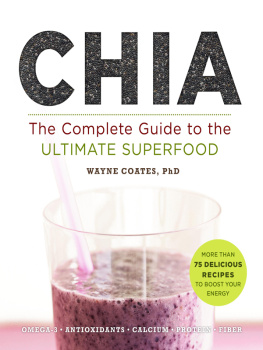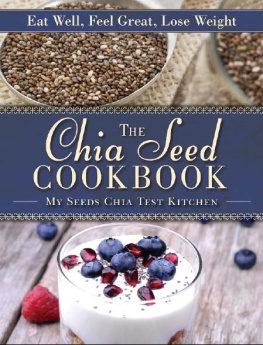Alive | Natural Health Guides |
Chia
USING THE ANCIENT SUPERFOOD
Beverly Lynn Bennett

ACKNOWLEDGMENTS
Id like to thank several people for their loving support and assistance during the writing of this book: Cynthia and Bob Holzapfel for their commitment to producing and publishing so many wonderful vegan and vegetarian lifestyle books and cookbooks, and for allowing me the opportunity to be a part of their respected family of authors. Jo Stepaniak, my friend and talented editor on this project, for her guidance and encouragement from the very beginning to the completion of this book. My husband, Ray Sammartano, for his love, support, and insightful comments, and more important, for being my chief taste tester during the recipe-development process. Luna, my feline companion, for supervising me in the kitchen while I was creating the recipes, and for the many purring sessions and snuggling lovefests on my lap while I sat at the computer. And last, all the vegans in the world for choosing to improve their lives, the lives of animals, and the future of this planet. Thank you for living with awareness and making a difference.



THE LEGENDARY CHIA SEED
Weve all seen them on TV and in our local stores: those cute clay figurines with the green sprout-covered tops known as Chia Pets. Since their introduction in the 1980s, these little indoor topiaries have contributed greatly to renewed interest in chia seeds as a food source and cash crop. One of the latest crazes to hit the food scene, chia seeds might be new to you, but theyve been cultivated and consumed for centuriesand rightfully so, as the chia seed is one petite powerhouse!
In the pages ahead, youll find information about the many nutritional and health-promoting benefits of working chia seeds into daily meals. Plus, this book also presents more than twenty-five tasty recipes, all of which incorporate chia in one form or another. These recipes contain only vegan ingredients, and many are also gluten-free or include substitution suggestions. So get ready to look and feel like a super-new you, simply by eating this superfoodchia seeds!
What Are Chia Seeds?
Chia seeds (pronounced CHEE-ah) are harvested from the Salvia hispanica plant, which is a member of the mint family. This staple crop has been grown for centuries in North, Central, and South America. A single chia seed is tiny, much smaller in size than the average sesame, flax, or hemp seed. Chia seeds have a mild, slightly nutty flavor, and come in shades of speckled black and white.
White chia seeds are rarer than the black variety and as a result are more expensive. Although the type of soil in which chia seeds are grown can affect the seeds nutritional content, most experts agree that there really isnt a significant nutritional difference between the white and black chia seeds.
Chia seeds are considered to be a whole food, as their bran, germ, and endosperm are still intact when they are packaged for sale. They are also mucilaginous, which means that when chia seeds get wet, they swell and secrete a sticky, gel-like substance. In turn, eating these seeds imparts a sense of fullness, which can help those who consume them to eat less and lose weight. Amazingly, chia seeds are capable of absorbing more than nine times their volume in liquid. The FDA classifies chia seeds as a food, not a supplement; therefore, they can be consumed without restrictions. Some experts even recommend feeding them to cats, dogs, and other animals.

Early Chia Seed Cultivation and Uses
There is documented evidence that chia seeds were cultivated as early as 3500 BC. The tiny chia seeds were highly prized by many early civilizations of the Americas, including the ancient Aztecs and Mayans of what is now Mexico, who used them in many different ways. In fact, the word chia is derived from the Nahuatl (Aztec) word for strength. The name of the Mexican state of Chiapas is derived from the word chiapan, meaning river of chia; it was named as such because it lies within the ancient Mayan territorial borders. Some historians believe that Aztec warriors and athletes could easily endure high levels of physical activity, long battles, and extensive journeys, maintaining their strength and stamina simply by consuming some water and a handful of chia seeds every few hours. Thats truly incredible!

For sustenance, these ancient tribes would mix chia seeds with water to make a beverage. They also ate the seeds alone or mixed them with their other main crops of amaranth, beans, corn, and squash. The ground seeds were used to make a mush or porridge.
The tribes added chia seeds to their medicines and used them to seal wounds and prevent infections. They also pressed the tiny seeds between rocks to extract their oil for use in making body paints. The Aztecs and Mayans held chia in such esteem that their high priests even made offerings of the seeds to the gods during their religious rituals.

So why did chia seeds slip into obscurity and remain virtually unknown to most of the world? European explorers and rulers might have contributed to chias fall from grace as a food source. In particular, as part of the Spanish conquest of the Americas, the invading Spaniards prohibited the so-called primitive and pagan religious rituals of the indigenous people, which often included the use of chia seeds. In an effort to weaken these tribes, the Spanish conquerors also banned the growing of many of their main crops, chia among them, and even went so far as to burn their agricultural fields. The Europeans feared that chia seeds and their properties of enhancing endurance and performance would make it impossible to control the native people and their precious territories.
Fortunately for us, the chia seed endured and continued to grow wild across much of the southwestern United States, Mexico, and Central America, and the indigenous people of these areas continued to consume chia seeds as part of their daily diet. Likewise, in the past few decades, chia seeds have been rediscovered by the masses, and we have agricultural and medical experts, in addition to health food advocates, to thank for the resurgence of interest in chia seeds and their consumption. Chia seeds are now being cultivated throughout the world, and as a result, these diminutive seeds have become a popular superfood and add-in ingredient in many food products. And its quite possible that those infectious Chia Pet commercials have added to the name recognition and widespread acceptance as well.
Next page

